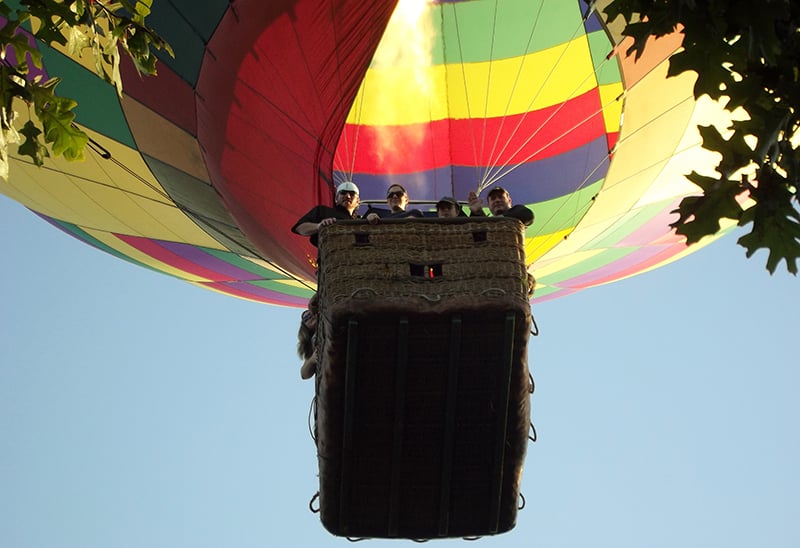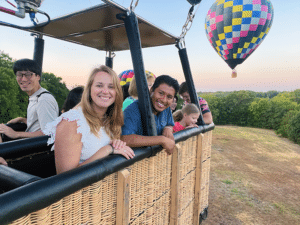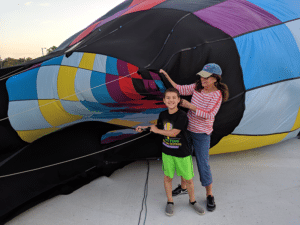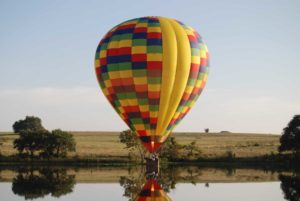What are the best seasons and times for balloon flights in Dallas/Fort Worth?
I am often asked by passengers what the best season, and the best time of day, typically is to go for hot air balloon rides in the Dallas/Fort Worth area, and why. I would like to provide some information to explain why I believe mornings are the safest and most enjoyable time of day to fly air balloons. I will also touch on why Summer, Fall, and to a lesser extent, Winter tends to provide the best hot air ballooning weather in North Texas.
To begin, balloon pilots do not usually attempt balloon flights in most places during the middle of the day, unless the local conditions allow for a stable atmosphere all day long. The daytime heating and resulting winds in most locations usually creates too much instability to be floating aloft safely in a big bag of hot air. The early morning sunrise hours are most often the times when the atmosphere is the most stable, and the best flights occur. The evening hours are another viable option for great balloon flights, but do not provide the necessary stability as often as the morning does. Excluding summer, I do schedule and provide some very enjoyable evening flights in and around McKinney, Texas when the temperatures are cooler, such as in most of the fall/winter/spring months.
Conditions that may affect whether we fly on any given day:
- Ground conditions (wet or muddy ground conditions may flying difficult)
- Turbulent winds (sometimes, even on a beautiful day, there may be turbulent winds at higher altitudes that prevent us from flying safely)
- Visibility (cloudy days may prohibit visibility and make hot air balloon flights more challenging)
Best Times of Day to Fly and Why:
- Sunrise is usually the most stable time of the day.
Hot air balloons need atmospheric stability and calmer, non-gusty surface winds. The primary reason for the high degree of stability around sunrise is that there is minimal to no vertical movement of air. This is usually kept in place for a couple of hours following sunrise by the effects of temperature inversion and cooler ground (soil, concrete, etc) temperatures. The normal environmental lapse rate of a parcel of air may be between 3 to 4 degrees Fahrenheit per 1,000ft ascent. The lapse rate from the surface to 3,000ft above ground level is a value that can be quite different between sunrise and sunset periods. With the loss of solar ground heating during the night, there is often a temperature inversion(s) that forms within 1,000 +/- feet of the ground, which results from cooler air forming on (or draining to) the surface with warmer air aloft, followed by the normal environmental lapse rate continuing above that. This layering of air is usually very stable because of the limited vertical movement of air due to the temperature and humidity differences and lack of a thermal engine below.The localized inversion layer along with the pressure gradient formed by the temperature variation between the more humid and warmer land to the east of North Texas and the dryer cooler land to the west commonly creates what is referred to as a “Low Level Jet” near the inversion layer. This LLJ is a higher speed horizontal wind layer separated from slower winds below and above it, allowing a balloon to travel faster and farther in this layer during the immediate post-sunrise hour or two. It is not uncommon to travel 20-60 mph in this layer, all while experiencing great stability and calm landings at the end of a flight. Passengers have little feeling that we travel as fast as we do aloft, and are amazed when I update them with our ground speed during a flight, as they have no feeling of speed or movement. It is important to note that not all LLJs exist in a stable enough environment for balloon flights, nor is the LLJ always present. The LLJ usually diminishes within 2 hours of sunrise due primarily to atmospheric mixing resulting from the solar heating of the ground. The surface heating and vertical air mixing typically results in an increase in surface winds and gusty conditions starting during the mid-morning hours, as well as a straightening out of the wind variation (less steerage – see #2 below) between lower and higher altitudes. These gusty conditions generally strengthen throughout the afternoon and are often still noticeable until sunset or beyond during the hottest months. Therefore, the morning flights are usually the best time of day for ballooning. - Sunrise flights have the most navigable winds of the day.Balloon pilots like “steerage”. This is our ability to change altitude to achieve a reliable change in direction, thereby allowing us to float a balloon in a direction (within a range of wind currents/altitude) that we want to travel. The horizontal layers of stable air commonly found near sunrise, combined with the predominant air mass characteristics in North Texas and the rotation of Earth, help illustrate a force named Coriolis Effect. Coriolis Effect is the natural deflection to the east resulting from the Earth’s rotation as one travels away from the equator. Coriolis effect is least pronounced near the equator, and is strongest near the poles. With a southerly air flow in North Texas (Northern Hemisphere), it is very common to have a counterclockwise or “left” wind direction on the ground below the inversion layer, and a “right” wind or deflection aloft (relative to the lower winds), caused by pressure gradients, Coriolis Effect and surface friction. The effects of these forces on wind variations at different altitudes lessens after sunrise as the air layers begin to mix vertically from solar heating, resulting in the loss of the wind variation immediately above the ground. The common phrase within the ballooning community for this surface level loss of steerage after sunrise is “the left leaves” or “the left left”. The lower left is not always present in North Texas, but since we have a predominantly southerly flow, it is found here more often than not. Even when the wind conditions are other than a southerly flow, these physical forces still affect our ability to better navigate balloons during the morning hours. Evening flights do not experience the same wind variation and ability to reliably steer a balloon because of the vertical movement/mixing of the air mass.
- The mornings have the most pleasant ballooning temperatures throughout the year.Some passengers have the assumption that flying during the cooler to colder months is very chilly and uncomfortable in the mornings. This is usually not the case, due to the characteristics of the atmospheric stability discussed above. The coldest part of a morning flight is almost always found during the balloon inflation on the ground. This is because cold air, being more dense than warm air, settles on the valley floors, which is where we like to launch. We commonly encounter 10-20 degrees Fahrenheit warmer air at an elevation between 300-600 feet above the ground than we find on the surface. Additionally, balloons travel with the wind, so the wind chill factor that causes much of the chilling effect is minimally found.
- Best and worst seasons to fly balloons in North Texas, historically:We truly have wonderful hot air balloon flights during every month of the year. However, the historically least likely we are to get our flights off the ground is during the spring season. Spring is our windy season, as we often see very unstable and damaging weather during Spring caused by the convergence of three very different air masses and the stronger southerly flow associated with the northerly advancing sun. The predominantly high winds usually start calming down in June/July and we see the majority of our flights from June through January. So if a Springtime flight is what you are after, I recommend flexibility with scheduling – they can be some of the most beautiful flights we do, but don’t happen as often as flights in other seasons of the year!
What was all that stuff above?
Every geographic location has different localized weather norms. North Texas is what we specialize in. I hope this post helps illustrate some of the primary reasons why we highly recommend sunrise balloon flights, and why the Summer and Fall seasons provide the lion’s share of our balloon flights for the year.
Ballooning safety, and what now?
All balloonists should have a very healthy respect for mother nature! Hot air balloons are inherently very safe, and as long as a pilot is properly taught and exercises good judgement and mental focus, I believe balloons can be considered much safer than many other aircraft, including fixed wing aircraft due to several factors which will be left for a future blog post. Our passengers’ safety is the absolute highest priority at Rohr Balloons. Once safety is fully considered, we aim to provide the highest level of customer satisfaction and entertainment in the industry. The whole ballooning excursion revolves around making our clients happy that they chose us for this wonderful adventure.
Soft Landings!
~ Brian Rohr, Pilot





